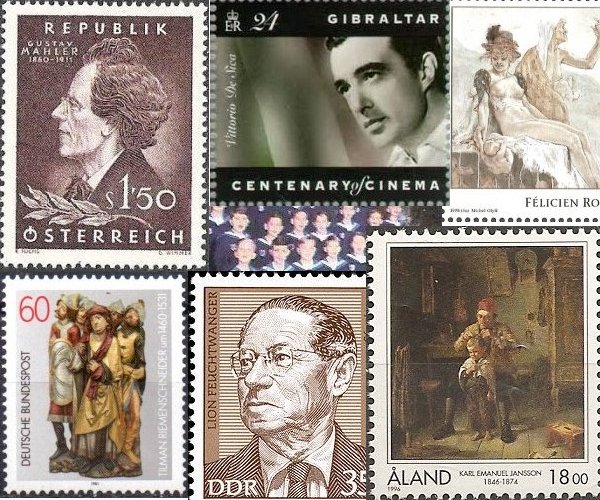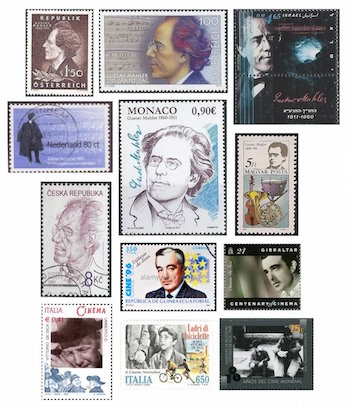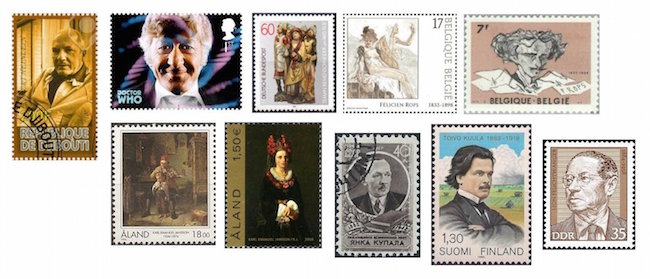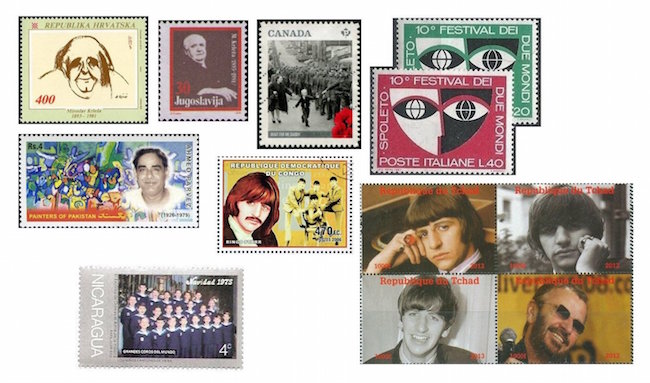The Arts on Stamps of the World — July 7
An Arts Fuse regular feature: the arts on stamps of the world.

By Doug Briscoe
Artists seemed to have lavished particular care on the designs for stamps honoring Gustav Mahler (1860 – 18 May 1911), who was born on July 7. The two Austrian stamps were issued for his centenary (1960, when Mahler’s music was not nearly so frequently heard as it is today) and sesquicentennial (2010). The striking Monaco design is also from 2010. The Israeli stamp, from 1996, is one of a series devoted to Jewish composers; the music shown is from the Resurrection Symphony. (Andris Nelsons conducts this masterpiece tonight at Tanglewood.) In 1995, the Amsterdam Concertgebouw Orchestra held a Mahler Festival, commemorated with a stamp quoting music I can’t identify. (There will be another Concertgebouw Mahler Festival in 2020.) The handsome Czech stamp was issued in 2000, and the Hungarian one is from a set of composer stamps dated 1985.
The great Italian director and actor Vittorio De Sica was also born on July 7th (1901 – 13 November 1974). Besides portrait stamps from Equatorial Guinea and Gibraltar that focus—pardon the pun—more on the actor, there are stamps from Italy and Argentina that salute his directorial masterpieces The Bicycle Thieves (1948) and Umberto D (1952).
Writers of science fiction have gotten short shrift on stamps of the world, and that may seem fitting and proper to those who haven’t read much in the genre. Admittedly, most of the science fiction movies have been junk, as are a lot of the books, but as an avid fan (and, ahem, a person of some discernment in literary matters), I must protest. Sci-fi has produced many writers of great talent, humanity, and, of course, imagination. One of the giants of the field was Robert A. Heinlein (July 7, 1907 – May 8, 1988), whose Stranger in a Strange Land (1961) was at one time a college campus fixture. The stamp comes from a sheet issued by Djibouti to which we’ll be returning from time to time in the, uh, future.

While on the subject of sci-fi, it seems a comfortable segue to mention that today is also the birthday of another Doctor Who, the third one in the series, Jon Pertwee (1919 – 20 May 1996), who had been in cabaret long before taking on the mantle of Doctor Who between 1970 and 1974.
On this date in 1531 the prolific German sculptor and woodcarver Tilman Riemenschneider died. Born about 1460 into a financially secure household (his father was a Master of the Mint and his uncle a notary), Riemenschneider settled in Würzburg and became established there, even serving briefly as mayor in 1520-21. He refused to take up arms against the peasants in 1525, however, and after the revolt was suppressed Riemenschneider was not only incarcerated and tortured along with other recalcitrant town council members, but forfeited most of his property and his former status. The stamp shows one of his works that has been richly painted, but much of Riemenschneider’s beautiful output was in unpainted wood and stone.
Belgian artist Félicien Rops (7 July 1833 – 23 August 1898) began his career as a lithographer and caricaturist. Moving from Brussels to Paris in 1862, he became interested in techniques of etching and created the frontispiece for a volume of poetry by his friend Baudelaire. Much of his work is plainly erotic, even pornographic (see, for example, his Saint Theresa), in keeping with the thematic material of some of the authors whose work he illustrated. One of his risqué pieces is offered on one Belgian stamp, while his self-caricature is on another.
With a natural talent for drawing, Karl Emanuel Jansson, born on the island of Åland on 7 July 1846, earned a scholarship to attend the Finnish Art Society in Turku. He studied further in Stockholm and Düsseldorf, but contracted tuberculosis and did not live to see his 28th birthday, dying on 1 June 1874. Two of his works have found their way onto stamps of Åland, which has a separate postal system from that of Finland: The Haircut (1867) and Peasant Bride (1869).

Belarusian poet Iván Daminíkavich Lutsévich (July 7 [O.S. June 25] 1882 – June 28, 1942) used the pseudonym Jánka Kupála. Initially he wrote in Polish, but soon turned to Belarusian and is considered one of that language’s greatest 20th century writers. His works were critical of the tsarist regime, and his nationalist views made him suspect in the eyes of the Soviets. Whether his fall down a staircase in the Moscow Hotel was an accident, suicide, or murder remains in dispute.
The short-lived Finnish composer Toivo Kuula (1883 – 18 May 1918), the first composition student of Sibelius, is best known for his lovely choral music, but he also wrote chamber and piano music and songs, along with two Ostrobothnian Suites for orchestra. A symphony was left unfinished at the time of his death. He was mortally wounded in a confrontation during the Finnish Civil War, dying of his wound three days after the war ended.
I said I knew something about literature, but now I must confess I’ve never read Lion Feuchtwanger (7 July 1884 – 21 December 1958), an author of great distinction. Born to an Orthodox Jewish family in Munich, he studied there and in Berlin, worked as a theater critic, then wrote plays before turning to the idiom of the historical novel. He was one of the earliest to recognize the seriousness of the threat of fascism, writing a satirical piece on the Nazis as early as 1920. His reputation was established with the novel Jud Süß (Jew Suss), which was made into a film in Britain in 1934 and was such an irritant to the Nazis that they created their own version, which perverted the story and characters, in 1940. Feuchtwanger continued his criticisms in The Oppermanns (1933) and The Pretender (1936). Unfortunately his condemnation of fascist excesses did not extend to the crimes of the Stalinists. When war broke out he was twice incarcerated before making a dramatic escape and settling in Los Angeles for the rest of his life. His 1947 play about the Salem witch trials, Wahn oder der Teufel in Boston (Delusion, or The Devil in Boston), predates Arthur Miller’s similar and more famous work The Crucible.
Another writer who puts the lie to my boast of an extensive knowledge of literature is Miroslav Krleža (7 July 1893 – 29 December 1981), who is cited as the greatest Croatian writer of the 20th century, but again, I’ve never read a word, so cannot form an opinion. He wrote plays primarily, but also poems, stories, memoirs, and four novels. A Communist from 1918, he was thrown out of the party in 1939 for his outspokenness about artistic freedom and the Stalinist purges. He had an on-again-off-again relationship with Tito, whose partisans Krleža refused to join during World War II, but who supported the writer to found and lead the Yugoslav Institute for Lexicography from 1950 until his death. Krleža is honored on stamps from both Croatia and Yugoslavia, although the latter is not a postage stamp but rather a postal tax stamp for local use.

American photographer Claude P. “Dett” Detloff (July 7, 1899 – July 18, 1978) worked for newspapers in Minneapolis, Winnipeg, and Vancouver, and that last city’s daily, The Province, printed Detloff’s most famous photo, taken on October 1, 1940 as the The British Columbia Regiment (“The Duke of Connaught’s Own”) was departing to fight the Axis. The picture came to be known as “Wait for Me, Daddy”.
I know of no stamps honoring Giancarlo Menotti (1911 – February 1, 2007) as composer, but Italy did issue this pair anticipating the tenth anniversary of the Festival dei Due Mondi (Festival of Two Worlds), founded by Menotti in 1958. Menotti later founded the companion Spoleto Festival in the U.S. in 1977. He is no doubt best known for his Christmas opera Amahl and the Night Visitors, but also won Pulitzer Prizes for two of his other operas. Generally regarded as an American composer, he always retained his Italian citizenship. He was the life partner of composer Samuel Barber.
Pakistani artist Ahmed Pervez (July 7, 1926 – October 5, 1979) came from Rawalpindi. His modernist paintings were first exhibited in Lahore in 1952. From 1955 to 1964 he lived in London, taking part in a two-man show with Alexander Calder in 1962. He also lived in the U.S. for two years in the late 1960s before returning to Pakistan. The writer of the online note at pakistanpaedia.com aptly describes Pervez’s work as consisting of “arcs, ellipses, whorls, and circles…used to build up a design that seemed to explode and erupt and fly apart but were firmly held together in a coherent pattern.” The artist’s cheerful work is exemplified on the stamp by a piece I was not able to identify by title or date.
We’ve seen Paul and George, and now it’s Ringo’s turn. Richard Starkey (born 7 July 1940) is the birth name of Ringo Starr. Among the stamps on which his image can be seen are one from Congo (DR) and a block from Chad.
According to Wikipedia, the Vienna Boys’ Choir “was, for practical purposes, established by a letter from Emperor Maximilian I of Habsburg on 7 July 1498.” Surprisingly, Austria has apparently never issued a stamp for the choir, but one from Nicaragua exists as part of a set of choirs (mostly boy choirs) of the world. (I love the mellifluent Spanish: “Los niños cantores de Viena.”)
A graduate of the University of Massachusetts with a B.A. in English, Doug Briscoe worked in Boston classical music radio, at WCRB, WGBH, and WBUR, for about 25 years, beginning in 1977. He has the curious distinction of having succeeded Robert J. Lurtsema twice, first as host of WGBH’s weekday morning classical music program in 1993, then as host of the weekend program when Robert J.’s health failed in 2000. Doug also wrote liner notes for several of the late Gunther Schuller’s GM Recordings releases as well as program notes for the Boston Classical Orchestra. For the past few years he’s been posting a Facebook “blog” of classical music on stamps of the world, which has now been expanded to encompass all the arts for The Arts Fuse.
